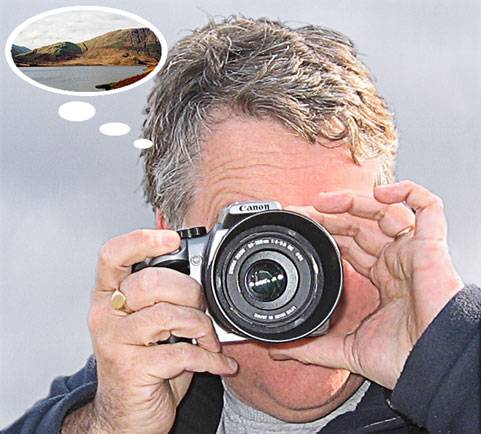
• Visualise the image you want •
Learning to “visualise” the image you want gives you the edge.
Visualisation – a world-class skill anyone can learn.
Photographers are distinguished from “snappers” by consistently and deliberately making photos which spark a vivid image in the viewers mind. The photographer relies on a clear image in their own minds to guide the creation of this image, rather than capturing by good fortune like the snapper. World-class photographers visualise a detailed image in their mind before the button is pressed.
Anyone can learn to visualise
Back in the early 1930’s Ansel Adams, a world-class landscape photographer, applied this technique to his photography. He said that the control of a photograph…
…lies in the selection by the photographer and in his understanding of the photographic processes at his command. The photographer visualises his conception of the subject as presented in the final print. He achieves the expression of his visualisation through his technique – aesthetic, intellectual, and mechanical.
Ansel Adams; “The Studio Annual of Camera Art”, 1934
Adams’ correspondence of the time showed that others were aware too. Today we all recognise the value of learning to visualise great outcomes for our work, or sports and our future success. So, why not our photography?
Learning to visualise in photography
What is visualisation? Simple. It is a detailed image in your minds-eye of how you want your final picture to look. A successful photograph will recreate the detailed image in your mind as a picture on-screen or print. But the viewer who sees it will get an experience beyond a mere picture. A successful image will come alive in the viewers mind.
Creating the mind-image? It takes a little practice. As we all have images in our heads. The trick is to make the image a good one. When you visualise an idea for your picture, plan it out – fill out the details. Keep the image in your head. Refer to it constantly. You learn to develop that detailed image by learning to observe the outside world. When you look at someone’s hair look at the texture and how the light falls on it. Check the way the shadows fall on their face. Observe sitting positions that flatter their body shape. You see a million details of the world around you every day. Learning to create a true image in your head is about being able to visualise those details in your minds-eye.
When you see a scene? The “snapper” will point and shoot. The photographer will consider the details. Look at the colour and quality of the light. Understand relationships between light and dark, shadow and brightness. Look at the lines and edges in the scene. Want to raise the impact? Change the scene in your head until you are happy with it. Visualise every detail and every intention you have for your image. Then, go make the changes.
Alternatively, picture the best composition. Exclude the distractions, consider the elements of composition and how you want them to catch the viewers eye in the final photograph. Figure out how you want the depth of field, motion blur, brightness and so on. Complete a visual experience in your head that will make the image real. Then reproduce it photographically.
Starting from scratch to design a scene, or composing one to represent your view of it, both have the same outcome. If you can visualise the scene as vividly as if it were real, then you have a chance to pass that on. It is passing that on to your viewers that is important. You are trying to create a vivid image in the viewers mind.
Taking the picture… When you are able to visualise an exciting image in your minds-eye you have already got your picture. Next create it in-camera. Command the digital processes to recreate what you want for the final image. NOW, and not before, set up your camera. Then take the picture.
Camera control is essential, auto-mode will definitely not recreate what is in your head. What you will find is that as your minds-eye image-making gets better, your technical skills increase to match it. Work at it and images on-screen will flow from images in your mind.
Great pictures
…flow from great images in your mind. If you make a great picture from your visualisation of the scene you will in turn create a great image in the mind of the viewer. The photographer gets excited and passionate about this translation because it is a unique and powerful communication with the viewer. You can learn this… you just need to visualise the details in your mind. Practice, and you will make great images.
 Photokonnexion tips by email
Photokonnexion tips by emailIf you enjoyed this article please sign up for our
daily email service.
Find out more…
Photokonnexion Photographic Glossary – Definitions and articles.
Directly relevant:
Definition: Visualisation (previsualisation)
Seeing what you want to create
Doing a Creative Shoot
Other useful links:
Light and Lighting – Resource pages on Photokonnexion
Texture
Composition
texture

Damon Guy (Netkonnexion)
See also: Editors ‘Bio’.
By Damon Guy see his profile on Google+.
